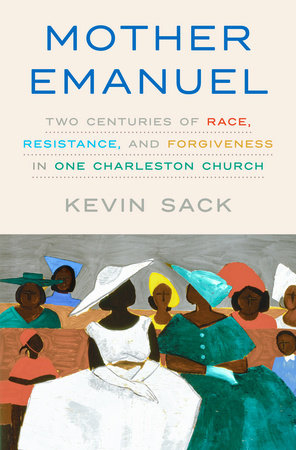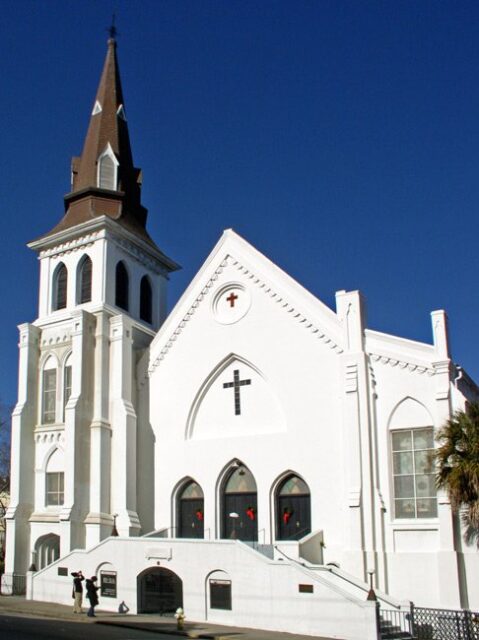
(RNS) — Kevin Sack had spent decades covering Black churches for The New York Times, so when he heard about a shooting at Mother Emanuel African Methodist Episcopal Church in Charleston, South Carolina, he knew this was no random act of violence. “As soon as it was broadcast that this was an African Methodist Episcopal church, my heart just sort of sank.”
After the murderer of the nine Black churchgoers was revealed to be a white supremacist, Sack was determined to tell a much broader, book-length story of the church, its denomination and the racial tensions that shaped both. The result is “Mother Emanuel: Two Centuries of Race, Resistance, and Forgiveness in One Charleston Church,” released June 3, days before the 10th anniversary of the massacre.
“When I explained to people that one of my goals was to make sure that the church wasn’t forever known only for what happened on the night of June 17, 2015, I think that resonated with members of the congregation who had a real appreciation for everything that had come before,” he told Religion News Service in an interview, “and felt that the remarkable drama of that story should not be lost in the horror of one night.”
The author spent the last decade unpacking the evolution of the Charleston church that once dominated the city with thousands of members. Like many historic churches, it has faced declining membership while grappling with expensive repairs to its aging building.
Sack, 65, now a freelance journalist, talked with RNS about the complexity of forgiveness for Black Americans, the political use of Mother Emanuel’s pulpit and how the Charleston church overcame its initial wariness about a white outsider’s presence there Sunday after Sunday.
RELATED: Biden calls out ‘poison’ of white supremacy in address at Mother Emanuel in S.C.
The interview was edited for length and clarity.
How’d you come to write this book about Mother Emanuel AME?
I went to Charleston for the Times to cover some of the aftermath. I wrote a long profile of (the Rev.) Clementa Pinckney and covered the eulogy (for him), in which President Obama sang “Amazing Grace.” I was starting to get familiar with the basic outlines of the church’s history and found that it had been the first AME church in the South and had this really interesting backstory almost at every point along, in the case of the church, the 200-year struggle for equal rights in this country.
Your book addresses the complicated topic of forgiveness, specifically related to Black Americans and Black churchgoers. How would you sum up what you concluded about that topic, specifically for Mother Emanuel and more generally?
I concluded that the forgiveness that was expressed by family members toward the killer wasn’t really for the killer; that it was more for themselves. After interviewing them extensively and speaking to theologians and folks on all sides of the forgiveness debate that emerged in Charleston, I decided that it really was more a form of release for those who forgave than a prayer for the soul of this unrepentant sinner. I started to understand that forgiveness in the context of the African American experience and in the context of Black Christianity really was more about a reclamation of agency. I assert that forgiveness in this context is really its own form of resistance, that it is a way to reassert power, when something of significance has been robbed from you.

“Mother Emanuel: Two Centuries of Race, Resistance, and Forgiveness in one Charleston Church” by author Kevin Sack. Image courtesy of Sack
You write that the Rev. Richard H. Cain, who helped build Emanuel AME in the 1860s, was a prominent preacher and a politician, including state senator, just like Rev. Clementa Pinckney. Do you see other parallels in the early leadership and the leadership at the time of the massacre at Mother Emanuel?
Cain was the pastor who revived the congregation in 1865 after the Civil War. He used Emanuel’s pulpit as a springboard into business, into publishing and into politics, running successfully for the state Legislature and ultimately for Congress. His career really sort of traces the arc of Reconstruction, both this incredible hope at the beginning, and the crushing of that hope at the end. And then there were very political speakers at the church over time. Booker T. Washington in 1909, W.E.B. DuBois in 1921, Dr. (Martin Luther) King in 1962. So when Pinckney becomes the pastor as a very highly regarded state senator, he’s following in the line of a long history of political activity from that pulpit.
You note the conservatism of the wider African Methodist Episcopal Church, even as some of its pastors have been progressive advocates for voting and other civil rights. How has Mother Emanuel reflected that dualism even to this day?
I found that all so curious and so interesting that these liberationist churches were also socially conservative, particularly on issues related to gay rights and same-sex marriage. And Emanuel reflects that in every way. I asked around pretty broadly and have yet to find anyone who would tell me of an openly gay member of the congregation, not just now, but ever. That doesn’t mean, obviously, that there aren’t LGBTQ members of the congregation, but nobody advertises it, and the denomination does not countenance same-sex marriage by its pastors, on threat of defrocking.
You also see Mother Emanuel as a church facing some of the same challenges other historic Black congregations are: aging buildings and congregations. How is it dealing with those realities?
The church really was a church in decline at the time of the shootings. Membership had been dropping steadily for years. Congregation was aging significantly. The biggest impact on both Emanuel and other African American churches in downtown Charleston has been gentrification. Property prices have just skyrocketed. Property taxes have skyrocketed along with it. And Emanuel, which was once very much a neighborhood church that everybody walked to, no longer is, and the members now live often a distant drive. I’m at the church lots of Sundays, and the altar call often goes unanswered. Nobody walks up (the aisle to join). The church also has real physical problems, structural problems. A study a number of years ago, when Rev. Pinckney was the pastor, discovered substantial water damage and termite damage, costing millions of dollars to repair. They’re in the middle of a two-phase campaign to raise the money to do those repairs.
The book reflects memories of relatives and other survivors of the massacre. How would you sum up what you learned about them and Emanuel in particular?
I found a congregation that remains deeply faithful and deeply committed to its traditions. The fellowship hall (the site of the shootings) is still used on a daily basis for meetings and classes. There’s an ongoing tension between the imperative to remember and to commemorate and the desire both to go back to a more innocent time before this happened, when the church was just their church, and also to move ahead and to try to progress and move the church forward.

Exterior of Mother Emanuel African Methodist Episcopal Church in Charleston, S.C. Photo courtesy of Mother Emanuel AME Church
You note that members of Mother Emanuel had “every reason to be wary of white people.” Were there times when people were concerned about your presence?
There’s a story that a couple of guys who are now close friends of mine tell — they’re trustees of the church — about one of the first Sundays when I visited, and I was up in the gallery (balcony) watching the service. They’re in the choir loft, and they see that I’ve got a black canvas work bag just large enough to conceal a weapon, and they kind of watch me open it up, and they breathe a sigh of relief when they see that I only pull out a laptop. And I get that. Who can blame them?
Do you have any religious affiliation?
I’m Jewish. So I understood, from the get-go, how much I had to learn and how much I was going to get wrong along the way, and maybe most importantly, how much I could not experience or feel the events I was writing about in the way that the members of this congregation could. On the other hand, I’m a journalist, and this is what we do. We go into unfamiliar territory and try to master the subject matter in a way that we can report back on it to our constituents.
It took me 10 years to feel that I had what it took to write this book, a couple hundred interviews and a lot of reading and a lot of thinking and very careful writing, but I sort of felt like the only way I can compensate is by putting in the work. And I hope that I have.
RELATED: Mother Emanuel’s forgiveness narrative is ‘complicated,’ says reporter-turned-author

